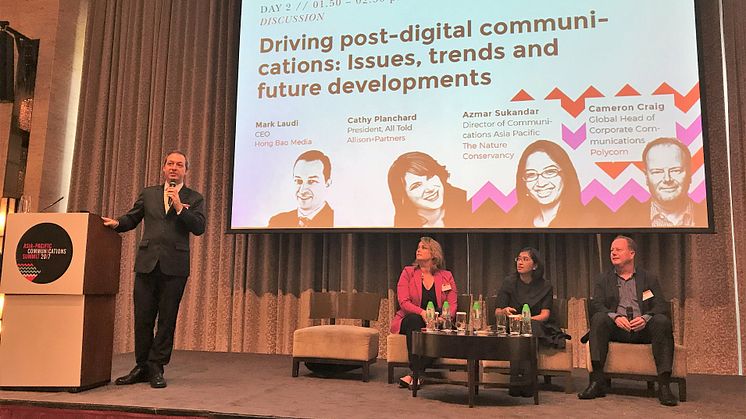
Mark Laudi moderating the final of the 2-day conference in Hong Kong
News -
Comms Directors: Which of these contradictions sound familiar?
The theme of the third annual Asia Pacific Communications Summit of "Driving post-digital communications" seemed a tad premature, given the struggle many communications directors have, just to get up to speed on digital.
But the APCS17 nailed the contradictions and the ambiguities Communications Directors face every day, and if you read on to the end of my post you will see why this was, actually, the most appropriate title.
Here are the top four. Do they sound familiar? Add your own in the comments.
- Digital vs traditional media – striking a balance between old and new media is a constant struggle for many Communications Directors. But the interdependence, rather than substitution, of traditional and new media was brought home by iflix CEO Azran Osman-Rani. His is a digital movie business. But he spends 30% of his ad budgets on old media channels. He showed a slide of his logo on out-of-home screens in Kuala Lumpur to illustrate the point. To build trust with customers online, they must experience the brand offline first. You can't just use traditional channels, but you must use them if you want to succeed with digital channels.
- Listening vs sending – the new media offer many ways to reach out to your target market. But APACD President Pierre Goad emphasised the need to listen to your stakeholders. This runs counter to the time and resources many Communications Directors spend on getting their message out to raise awareness. Alan Hilburg implored delegates to listen first (outside in), then communicate (inside out), while Cathy Planchard's approach was that in order to bring about a dialogue you must send messages first. Yet another contradiction was the finding by the Asia Pacific Communication Monitor that many Communications Directors actually use their prime listening tool – social media – to broadcast in the old-fashioned way.
- Honesty and trust vs messaging – even as Communications Directors have different channels at their disposal to both listen to consumers and to send messages, these must rest on a foundation of trust. But here was another contradiction, not just at the Summit, but one I see repeated in our messaging and media training workshops: the need to send out messages, but to do so honestly; the need to raise awareness, but – as Alan Hilburg said – to also build trust. At another event I hosted recently for Lloyds, I invited our several hundred guests from the shipping industry to tell the person next to them how business was doing (the shipping industry has been going through difficult times for several years) …and then to repeat the exercise, but to imagine that the person next to them was a journalist. Needless to say, their descriptions became dramatically rosier. Few Communications Directors would be prepared to tell it exactly as it is. But with consumer trust in institutions through the floor, they might soon have to.
- Using influencers vs being an influencer – Paul Mottram and Cameron Craig discussed these at length in separate sessions. Paul's company's research showed just how influential influencers and Key Opinion Leaders (KOLs) are, and therefore what value they could be to Communications Directors. But he also reflected on the moral hazard of paying them for coverage. One of the six best practices highlighted by Cameron Craig was to move up from engaging influencers to becoming on influencer, but only once five other difficult conditions were met. In general, I find the term thought-leader is totally overused. When everyone succeeds in being a thought leader, no one will be. In truth, very few people succeed. To borrow from Alan Milburg, you must be the most sought-after and the most trusted.
What other contradictions did you come across, and how are you dealing with them?
